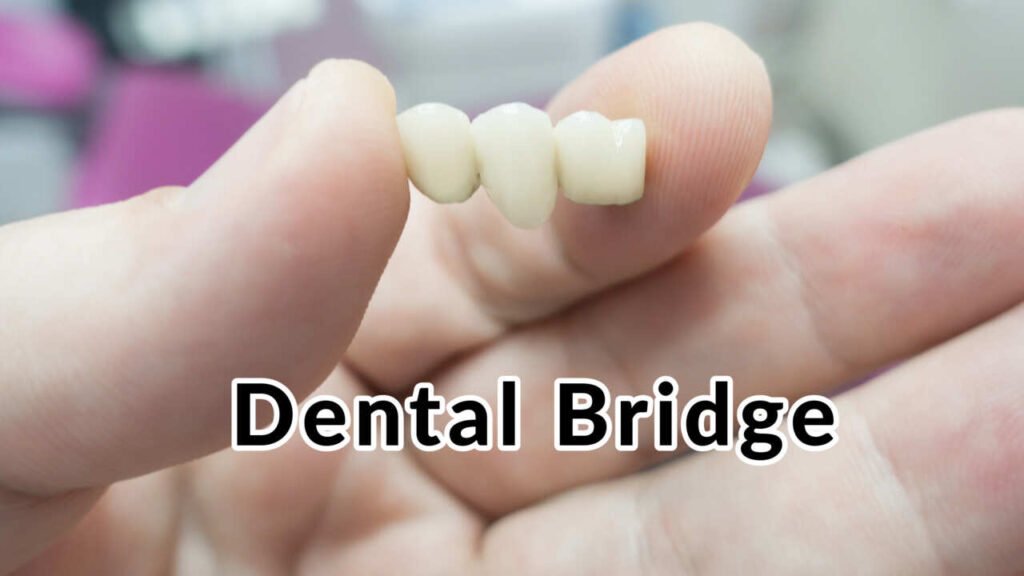
Dental Bridge: A Comprehensive Guide
What is Dental Bridge
A dental bridge is a permanent appliance placed in mouth that replaces a missing tooth or teeth. It can fill the gap between two healthy teeth where one or more teeth are missing.
It consists of artificial teeth, known as pontics, which are anchored in place by crowns or caps attached to the teeth adjacent to the gap.
Dental bridge can be made up of materials ranging from metal, ceramic, zirconia and even acrylic in some cases.
When is a Dental Bridge Needed?
Dental bridges are recommended for individuals with one or more missing teeth who seek to restore their smile, improve chewing and speech, prevent shifting of remaining teeth, and maintain facial structure. It is not considered as a good solution for replacing missing teeth.
How Dental Bridge is Used?
The dental bridge procedure involves preparing the adjacent teeth to receive teeth caps, which serve as anchors for the pontic teeth. The bridge is custom-made to fit the patient’s mouth and is permanently cemented in place.
Types of Dental Bridges Available
Different types of dental bridges include
- Traditional bridges (bridge takes support on both side)
- Cantilever bridges (bridge takes support from on one side)
- Maryland bonded bridges (bridge takes suport from both side, from behind the teeth),
- Implant bridge (bridge is supported by implants instead of natural teeth)
How Crown Bridge Procedure is Done
The procedure for placing a dental bridge involves several steps, including an initial consultation, tooth preparation, impression taking, bridge fabrication, and final placement.
Before the Procedure
Patients may undergo a dental examination and possibly dental X-rays to assess the health of the surrounding teeth and bone structure. Preparatory steps may include addressing any existing dental issues, such as cavities or gum disease.
During the Procedure
Tooth preparation involves reshaping the adjacent teeth to accommodate the crowns. Impressions are then taken to create a precise mold for the fabrication of the bridge. Temporary bridges may be placed while the permanent bridge is being made in a dental laboratory, usually it takes 4-5 days to get the crown bridge back from lab, which is fixed using dental cement.
After the Procedure
Patients are advised on post-procedural care, which may include practicing good oral hygiene, avoiding hard or sticky foods, and attending follow-up appointments. Discomfort and sensitivity are common initially but should subside as the mouth adjusts to the new bridge.
Typical Recovery Time
Recovery time after a dental bridge varies, but patients can typically resume normal activities shortly after the procedure. Any discomfort or minor adjustments can be addressed during follow-up visits.
Risks and Benefits of Dental Bridge
Risks: Potential risks associated with dental bridges include
- Tooth sensitivity
- Decay of the supporting teeth (since cleaning under the bridge is challenging
- Gum disease. In rare cases, complications such as bridge failure or allergic reactions to materials may occur.
Benefits: Dental bridges offer numerous benefits
- Including improved aesthetics,
- Restored function for chewing and speech
- Prevention of teeth shifting
- Preservation of facial structure.
Precautions & Care for Your Dental Bridge
Precautionary Measures Patients should follow proper oral hygiene practices including :
- Regular brushing and flossing (thread or water flosser)
- Use a non- abrasive fluoride toothpaste
- Clean underneath your bridge every day using floss threaders or water flosser or interproximal brushes (tiny brushes made to go between your teeth)
- Avoid extremely hard or chewy foods.
- Don’t chew on ice, pens, pencils or your fingernails.
- Visit your dentist regularly for checkups and cleanings.
Long-Term Care
- Maintenance: Proper maintenance of dental bridges involves regular dental check-ups, professional cleanings, and monitoring for any signs of damage or deterioration. Good oral hygiene habits at home are essential for the longevity of the bridge.
- Follow-up Appointments: Patients are advised to schedule periodic follow-up appointments with their dentist to ensure the bridge remains secure and functional. Any concerns or issues can be addressed promptly during these visits.
How Long a dental bridge lasts
Patients are curios to know if dental bridge is permanent? The longevity of a dental bridge varies depending on several factors, including the quality of materials used, oral hygiene practices, and individual lifestyle habits.
On average, a well-maintained dental bridge can last anywhere from 5 to 15 years or more. Factors that can affect the lifespan of a dental bridge include:
- Material Quality: High-quality materials, such as porcelain fused to metal or zirconia, tend to be more durable and long-lasting compared to less durable materials.
- Oral Hygiene: Proper oral hygiene, including regular brushing, flossing, and dental check-ups, is essential for maintaining the health of the supporting teeth and gums. Poor oral hygiene can lead to decay or gum disease, which may compromise the integrity of the bridge.
- Diet and Lifestyle: Chewing hard or sticky foods and habits like teeth grinding (bruxism) can put excess strain on the bridge and its supporting teeth, potentially leading to premature wear or damage.
- Adjacent Tooth Health: The health and integrity of the adjacent natural teeth play a significant role in the longevity of the bridge. If these teeth develop issues such as decay or gum disease, it can impact the stability of the bridge.
- Professional Maintenance: Regular dental check-ups and professional cleanings allow dentists to monitor the condition of the bridge and address any issues early on, prolonging its lifespan.
While dental bridges offer a reliable solution for replacing missing teeth, they are not permanent fixtures. Over time, normal wear and tear, as well as changes in oral health, may necessitate replacement or repair of the bridge. Consulting with your dentist regularly can help ensure the longevity and effectiveness of your dental bridge.
What Happens If You Opt for No Dental Bridge Treatment?
Choosing not to undergo dental bridge treatment can have several consequences, both in the short term and the long term. Here are some potential outcomes:
- Tooth Shifting: When a tooth is missing, adjacent teeth may begin to shift or drift into the empty space. This can lead to misalignment of the teetth, bite, and jaw function.
- Bone Loss: The bone supporting the missing tooth begins to deteriorate due to lack of stimulation from chewing. Results in bone loss , which compromises the stability of neighboring teeth
- Difficulty Chewing and Speaking: Missing teeth pose challenge in chewing food, leading to dietary limitations and potential nutritional deficiencies. Speech is affected, especially if front teeth are missing.
- Esthetic Concerns: Gaps from missing teeth can impact the appearance of the smile, affecting self-confidence
- Increased Risk of Dental Issues: Misaligned teeth and changes in bite alignment resulting from tooth shifting can increase the risk of dental problems such as tooth decay, gum disease, and temporomandibular joint (TMJ) disorders.
- Treatment Complexity: Delaying or forgoing dental bridge treatment may result in more complex and costly dental procedures in the future to address the consequences of tooth loss, such as orthodontic treatment, bone grafting, or dental implants.
Ultimately, the decision to pursue dental bridge treatment or not depends on individual circumstances, including oral health needs, budget, and personal preferences.
Cost of Dental Bridge in India
Cost Considerations: The cost of a tooth bridge in India can vary from Rs 12000/- – Rs 45000/- varies depending on factors such as
- The number of pontics (missing teeth)
- The materials used – metal, ceramic or PFM, Zirconia, or layered zirconia
- The complexity of the procedure
- To caluclate cost of dental bridge, find out cost of a teeth cap and multiply it with number of missing teeth and add cost of two teeth caps to the total. One Missing tooth means a 03 unit bridge or 3 teeth bridge.
Insurance Coverage: Some dental insurance plans may cover a portion of the cost of dental bridges, particularly if the procedure is deemed medically necessary. Patients are encouraged to check with their insurance provider to determine coverage options and any out-of-pocket expenses.
Frequently Asked Questions About Dental Bridge
By choosing a dental bridge, individuals can restore their smile and oral function with a durable and natural-looking solution. Consulting with a prosthodontist can provide personalized guidance and ensure optimal results for long-term oral health and well-being.
Dental Procedure Cost In Gurgaon
Explore the cost of dental procedures at our clinic in Gurgaon. For detailed information, visit: Dental Procedure Cost
Book Appointment with Best Dentist in Gurgaon
Schedule an appointment with our experienced dentists in Gurgaon. Click here to book: Book Appointment

Dr. Jyoti Singh (MDS), Diplomate WICO (Japan region) stands as a beacon of excellence in implantology within Delhi NCR region. She is a BDS and MDS(Prostho) both from Maulana Azad Institute of Dental Sciences, where she secured top honors with all India rank 1 in PG entrance examination. Her extensive experience at esteemed institutions like Clove Dental and her own Center for Dental Implants & Esthetics since 2016, Dr. Singh embodies unparalleled expertise in dental implants. Boasting a wealth of 16 years in dentistry and backed by 18 groundbreaking research papers in leading international journals (Google Scholar) and her ResearchGate profile, she epitomizes the pinnacle of proficiency and innovation in her field. She practices in Gurugram as your friendly dentist near me.
